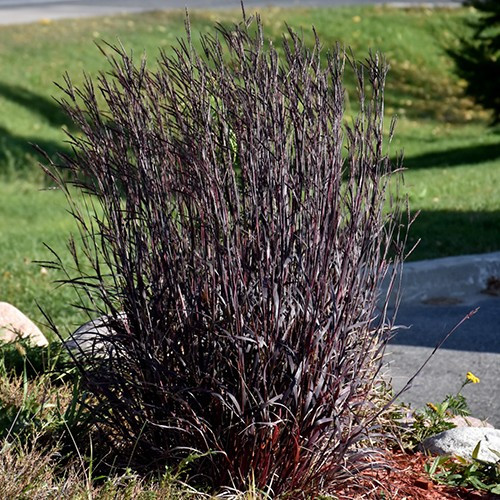| Andropogon gerardii 'Dancing Wind' |
USDA Zone: 3-9 |
Dancing Wind Bluestem is primarily grown for its highly ornamental fruit. The burgundy seed heads are carried on showy plumes with coppery-bronze overtones, which are displayed in abundance from late summer to mid fall. Its attractive grassy leaves emerge grayish green in spring, turning green in colour with showy red variegation. As an added bonus, the foliage turns gorgeous shades of burgundy and coppery-bronze in the fall. The red stems can be quite attractive.
This wonderful selection of native prairie grass will reach five to six feet tall with foliage that develops red highlights, then turns burgundy-copper in fall; deep red flowers held on red stems in late summer; plant in full sun for best color.
Dancing Wind Bluestem is recommended for the following landscape applications;
- Vertical Accent
- Mass Planting
- General Garden Use
Attracts Birds
Attracts Butterflies
Deer Resistant
Low Maintenance
Drought Tolerant
Common Name: Big Bluestem, Turkey Foot, Ornamental Grass
|
Key Feature
|
Light Needs | Landscape Uses |
 |
 |
|
|
|
|
| More About Dancing Wind Bluestem |
| Height: 5 ft |
Spread: 2 ft |
Flower Colour: Burgundy / Red Shades |
|
Bluestem adapts easily to a wide range of soil and moisture conditions as long as full sun is provided. This long-lived grass has a variety of uses including screening, naturalizing, restoring prairies, and nesting materials for birds and mammals. Dancing Wind Bluestem should only be grown in full sunlight. It is an amazingly adaptable plant, tolerating both dry conditions and even some standing water. It is considered to be drought-tolerant, and thus makes an ideal choice for a low-water garden or xeriscape application. This plant does not require much in the way of fertilizing once established. It is not particular as to soil type or pH, and is able to handle environmental salt. It is highly tolerant of urban pollution and will even thrive in inner city environments. Warm Season Grasses: These grasses are much slower starting in the spring. They do not push new growth until temperatures warm in early to midsummer. They flower later in the summer or fall with most blooms remaining into the winter. Most warm season grasses tolerate heat, humidity and drought; some even thrive in these conditions. Note that when grown in a container, it may not perform exactly as indicated on the tag - this is to be expected. Also note that when growing plants in outdoor containers and baskets, they may require more frequent waterings than they would in the yard or garden. Be aware that in our climate, most plants cannot be expected to survive the winter if left in containers outdoors, and this plant is no exception. NOTE: Some flowers and plants may be harmful or poisonous to people or pets if touched or ingested. If you require more information before placing an order, please let us know in advance. |










